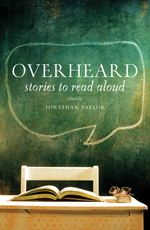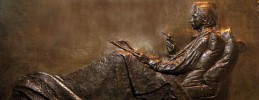
photo by Rawku5
by Jonathan Taylor
Over the last fifteen years, I’ve organised, hosted, compèred, and participated in dozens – maybe hundreds – of live literature events. Through my own small arts organisation, Crystal Clear Creators, I’ve also been involved in recording and broadcasting a huge amount of writers’ work. In both these live and recorded contexts, I’ve come across many prose fiction writers who are just as keen to read and perform their work as poets.
Even though ‘open-mic’ literature events are generally associated with poetry (and sometimes with particular kinds of poetry), there are almost always at least a few fiction writers at these events who want to perform their stories. And people want to listen too – there is no doubt in my mind that adults, as much as children, love having stories read aloud to them. This is probably why, in recorded formats, there is a long history of short stories being read and performed – on audiobooks, on BBC Radio 4, and, more recently, on the many local, community, web-based and arts-based stations springing up around the country, such as Resonance FM, Short Story Radio and Radio Wildfire, to give just three examples among many.
Although the tradition of short stories being read on radio has received some attention – and often very large audiences – the ever-increasing phenomenon of stories being performed live has been rather overlooked, at least by critics and print publishers. By contrast, poetry in performance has received a great deal of critical attention, and there are numerous books and anthologies which attempt to capture its energy and power. There is virtually no comparable literature for stories in performance, which is why I decided to put together Overheard: Stories to Read Aloud.
 The lack of attention on stories in performance ignores the development, in recent years, of a number of organisations in the UK which actually specialise in live performances of short fiction. To name but a few, ‘Short Fuse Fiction’ in Leicester, ‘Rattle Tales’ in Brighton, ‘Electric Tales’ in Edinburgh, ‘Are You Sitting Comfortably?’, ‘The Book Stops Here’, ‘Storytails’ and ‘All Ears’ in London, ‘Liars’ League’ in London, Leeds and New York, and ‘Literary Death Match’ in venues worldwide.
The lack of attention on stories in performance ignores the development, in recent years, of a number of organisations in the UK which actually specialise in live performances of short fiction. To name but a few, ‘Short Fuse Fiction’ in Leicester, ‘Rattle Tales’ in Brighton, ‘Electric Tales’ in Edinburgh, ‘Are You Sitting Comfortably?’, ‘The Book Stops Here’, ‘Storytails’ and ‘All Ears’ in London, ‘Liars’ League’ in London, Leeds and New York, and ‘Literary Death Match’ in venues worldwide.
The development of these organisations is partly a belated offshoot of the poetry performance scene, which dates back to the 1980s and beyond. It is also an offshoot of the popular revival, in the last few decades, of ‘traditional’ oral storytelling, aided by the foundation of the Society for Storytelling in 1993.
No doubt these dual origins – the poetry performance scene on the one hand, and traditional oral storytelling on the other – continue to influence the kinds of stories which are performed at live events. Stories which come off well in performance often share certain characteristics with poetry. They sometimes employ refrains, such as repeated phrases, sentences or images, which help orientate the audience within the story. They sometimes use strong rhythms, even (occasionally) rhymes, in their sentences. And their language is often ‘musical’ (though not over-written) in the broadest sense. Indeed, the musicality of their language is of fundamental importance, given that audiences generally don’t, or can’t, follow the intricacies of plot on hearing a story for the first time – what matters more is the moment-to-moment pleasure of musical language.
Successful stories in performance also frequently share characteristics with traditional tales. To generalise, they are often formally conservative (without using that term in a pejorative sense); they are chronologically linear, with a definite beginning, middle and end (however ambivalent), so that the form is immediately obvious to the audience; they tend to concentrate on one main character, or one main relationship; they are short, sometimes very short; they are precise, with short sentences and straightforward diction; they are generally conversational, even chatty in style – to the point that first-person stories shade into monologues; they include relatively little outward description; and they are self-contained, in that they need little or no introduction or contextualisation from the author (that is, the kind of contextualisation which poetry in performance often does require).
 Many of these characteristics, that are shared with traditional oral tales, are also shared with other short stories generally. There are considerable overlaps, of course, between all genres and sub-genres of storytelling – as there are between all literary genres. Nonetheless, I have come to the conclusion that, over the last couple of decades, a new genre (or sub-genre) of short fiction has started to emerge – that is, the genre of the performance story.
Many of these characteristics, that are shared with traditional oral tales, are also shared with other short stories generally. There are considerable overlaps, of course, between all genres and sub-genres of storytelling – as there are between all literary genres. Nonetheless, I have come to the conclusion that, over the last couple of decades, a new genre (or sub-genre) of short fiction has started to emerge – that is, the genre of the performance story.
This genre is a hybrid; it is at once alike and unlike traditional oral storytelling, alike and unlike nineteenth and twentieth-century short fiction in print. Stories within this genre can be differentiated from oral tales and printed fiction in various ways, not least because they aim to work in both print and oral forms. Stories in performance aim at a knowingness, or formal sophistication, their morals are further below the surface, or more ambivalent than oral stories, and the language becomes just as important as the narrative itself.
Humour is also common in such stories – maybe more a matter of wit and wordplay than outright comedy – and this humour is often mixed with other, conflicting emotions. Stories in performance are also often more introspective than traditional oral tales. Having said that, there is considerably less introspection in a performance story than there is in a novel, or longer story suitable just for print publication. For an audience not to become bored, the introspection in a performance story, obviously, has to be carefully controlled.
Oddly enough, there seems to be a recurrent theme in the nature assumed by this introspection. One of the surprises, when compiling and editing the stories for Overheard, came when I realised that several of them involved dealing with alternative states of consciousness. Many of the main characters in these stories are wrestling with their own, problematic self-consciousnesses, which seem full of holes, abysses of forgetfulness and self-forgetfulness. Whether due to drug abuse, delusions, mental illness or trauma, the characters are feeling their way around both their environments and their own minds, as if from scratch.
I can only speculate on why this is a feature of so many of the performance stories in Overheard, but I think it might have to do with the nature of the genre itself – the character’s semi-blank mindset at the start of a story reflects that of the audience, which similarly has no idea of this particular character’s history, context or background; they are also starting from scratch. Moreover, the character’s fragmented consciousness might well reflect the audience’s in hearing the story for the first time. Just as the characters in these stories find it hard to piece together any coherence out of their shattered consciousnesses, so an audience – as I have said – might not follow a story as a whole, might not follow the intricacies of plot, but rather just enjoy the story on a moment-to-moment basis as musical language, as a series of striking images. At a profound level, I believe that the pleasure afforded by this strange kind of fusion, between character and audience, is one of the reasons for the continuing, and ever-increasing, popularity of the genre of stories in performance.
~

